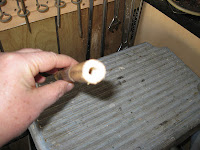| This is load 2 of 3. It's cheaper to have rock delivered in these bags on their flat bed. Pain to empty them though. Ed drags them with the truck to tip them over. |
What madness has inspired me to do this? Gardening of course. I have two projects in the works for the back yard. The first is to create wicking vegetable beds with rock pathways and an arbor. The second is to install a pond. Both required a lot of rock. Today I finally wised up and got up at 5 am to shovel the stuff, getting in several hours before the death star rose to slay me.
My "wicking" project is an expansion of the ditch on the uphill side of the house. This area catches and holds the runoff from my neighbors lawns on my block. It's a substantial amount of water when we get one of our Texas thunderstorms - almost of inch of water in about 30 minutes. My idea was to dig it out further, replace the soil with larger rock, then direct the water between some of my vegetable beds and the blackberries.
 |
| The concrete pavers function as "gates" to slow down the water so it can soak in. I got the idea from how the flood irrigation was set up on the sheep pasture we used to rent. |
The rock I used was 3" crushed limestone. I was hoping to find something else that wouldn't make my soil even more alkaline, but the price difference was huge. So I'll just count on the compost in the vegetable beds to offset the higher pH. Good thing I collect coffee grounds from work!
Once a layer of this went down, I topped it with 3/4" crushed granite. I really like this rock. It's a pretty shade of pink and I just love the crunchy sound it makes when I walk on it. (I blame the Masterpiece Theater shows on PBS. All those estates with crushed rock driveways.) By topping the larger with the smaller rock, it settles in nicely and packs down to make a firmer surface. This is pretty important since this is a major pathway for the wheelbarrow and hand truck, and I need to have both wheel along without me having to fight it too much.
 |
| 3" crushed limestone used as the path bed. The water should flow through here nicely without relocating anything. |
All that for sweet berries? Why not? I figure all in all it's cheaper than a treatment at Lake Austin Spa and Resort although I could REALLY use a manicure after handling all that stone!












































